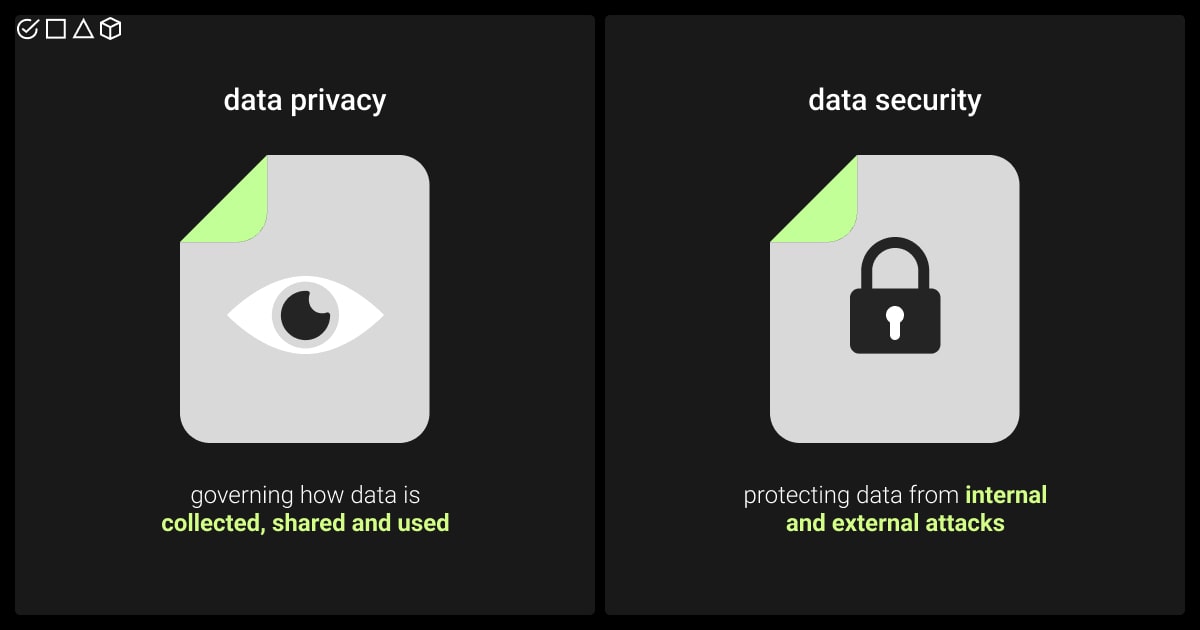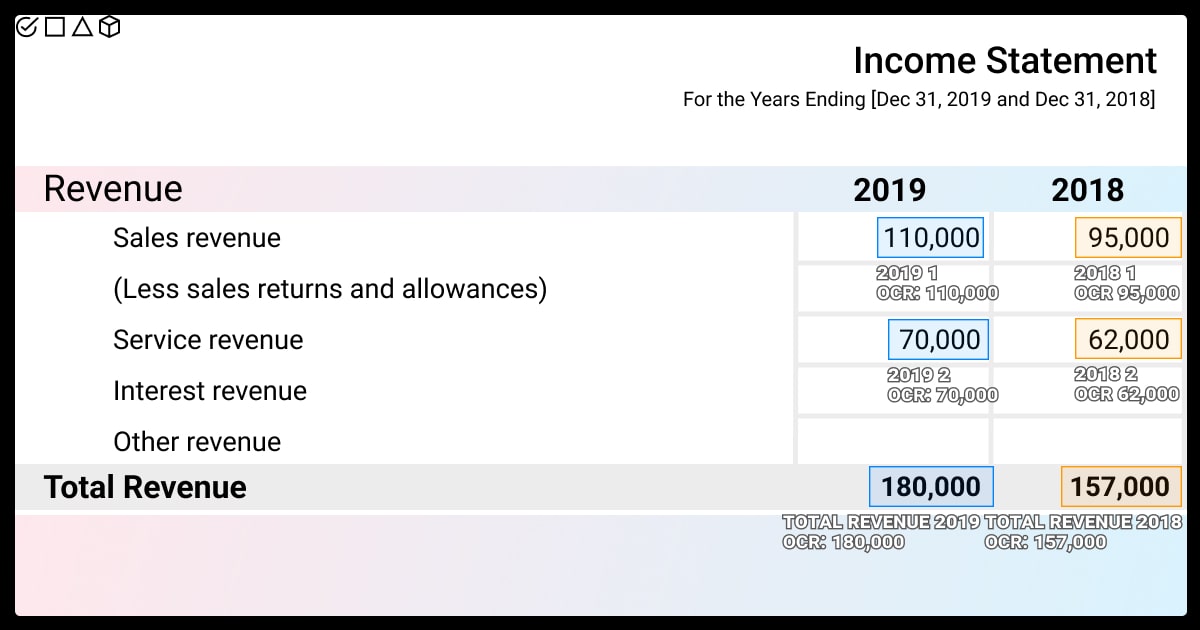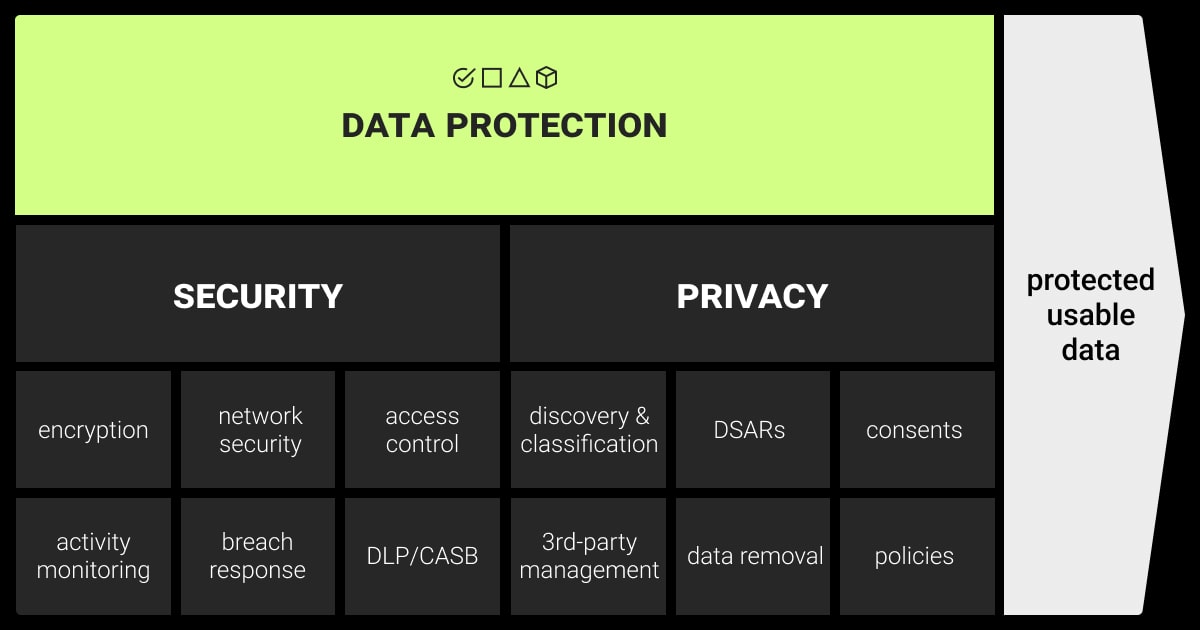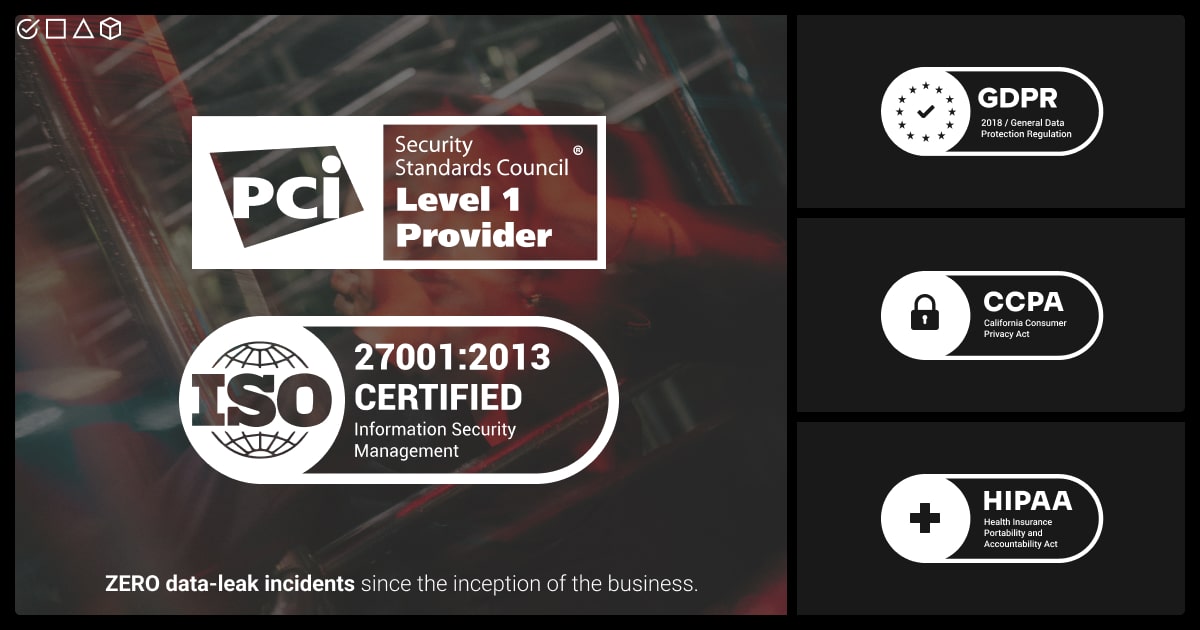94% of businesses risk losing customers if they don’t protect personal data, as 81% of consumers say a company’s treatment of their data reflects its view of them.
When we go online, everything we do leaves behind a trail of data. With just a few lines of code, this data can easily be traced back to us as individuals. That’s why many people feel concerned about how little control they have over their personal information, especially when it’s in the hands of governments and corporations.
But this concern about data security and privacy isn’t just important for regular internet use; it’s also a big deal in areas like AI and data labeling. The latter requires strict attention to security for several important reasons:
Protecting individuals’ privacy whose data is being utilized.
Preventing fraudulent or harmful exploitation of the data.
Ensuring the data remains accurate and relevant.
Thus, when outsourcing data labeling services, you should consider the relevant laws and regulations for data security and privacy. Read on to learn more about how to secure data annotation and choose a trusted AI partner for your project.
How to Secure Your Data Annotation Workflow?
On average, it takes 50 days to discover and report a data breach. During that time, businesses risk significant harm, including unauthorized access, financial losses, and reputational damage.
The implementation of privacy and security measures is already on the list of this year’s data annotation trends, as this process often involves personal and even sensitive data. Yet, ensuring privacy regulations are followed can be tough when labeling personal data. You need systems that keep the data private by not letting people directly interact with it.
Personal data means any information about a person that can identify them or help identify them. This includes names, addresses, or even browsing histories collected by websites. There are different types of personal data:
Provided data: This is information that you intentionally give, like filling out a form online.
Observed data: Collected automatically, when websites track which pages you visit using cookies.
Derived data: Created by analyzing raw data, when companies use algorithms to predict your preferences based on your past behavior.
Inferred data: This is conclusions drawn from multiple pieces of data when AI is used to guess your interests based on your online activity.
When seeking a data labeling service, consider the following:
Annotators security:
Ensure that all annotators have undergone background checks and have signed non-disclosure agreements (NDAs) or similar documents outlining your expectations for data security. Managers should closely monitor compliance with these data security protocols.
Device control:
Annotators should surrender any personal devices, such as mobile phones or external drives, upon entering the workplace. The service provider should also disable any features on work devices that could allow data downloading or storage.
Workspace security:
Workers should conduct their tasks in a location where their computer screens are not visible to individuals who do not meet the specific data security requirements for your project.
Infrastructure:
The choice of data labeling tool also plays a crucial role. A company should offer an appropriate tool or recommend the best options based on your unique needs and security standards. The best option is when a data labeling company has a solution to offer and can also seamlessly integrate with your annotation tooling.
Are you seeking data labeling services that ensure the utmost security and privacy? Get in touch with our team at Label Your Data to experience industry-leading security standards.
Data Security vs. Data Privacy

Data labeling security and privacy are related but different concepts. Data security focuses on protecting electronic information from unauthorized access, while data privacy concerns individuals’ rights to control how their personal data is collected and used.
As businesses increasingly use AI and ML technologies, the importance of data security has grown. Moreover, there are compliance issues related to data privacy that require careful consideration. Training data, which might include sensitive personal information like names, addresses, and birthdates, carries risks if mishandled, potentially leading to identity theft, fraud, or other malicious actions.
The reason these two concepts are often intertwined is that they both revolve around data protection. Besides, the link between data privacy and data security in annotation has become stronger due to the rise of regulatory frameworks such as the General Data Protection Regulation (GDPR) and the California Consumer Privacy Act (CCPA).
How Data Security & Privacy Laws Impact Data Labeling

Privacy laws differ greatly from one place to another, but the common ground between them is that they help us manage data protection. That is, how our data is being collected and used. Today, over 120 countries have enacted international data protection laws to better safeguard their citizens’ data.
The most extensive data protection and privacy regulation so far is the General Data Protection Regulation (GDPR), introduced in 2018 in the European Union and the European Economic Area. According to GDPR, people have the right to know how their information is being handled and to have more control over their data online.
GDPR covers various processes, including:
Gathering personal data,
Developing AI algorithms using personal data,
Analyzing data to make decisions.
Overall, it ensures that those who own or handle data follow the law and are socially accountable. One important aspect of GDPR compliance is having a lawful reason to process personal information. There are six lawful bases for processing: consent, contract, legal obligation, vital interests, public task, and legitimate interest. The most suitable basis is usually determined by legal professionals based on factors such as the purpose of processing and the relationship between parties. The privacy notice should clearly state the lawful basis for processing and the reasons for it.
When partnering with a data labeling company, both parties need to establish an agreement that outlines specific labeling details. This agreement should ensure confidentiality, compliance with laws and regulations, and the deletion or return of data after processing ends.
It should also cover:
Subject matter,
Purpose of processing,
Timeframe for processing data,
Types of personal data involved,
Obligations,
Rights.
It’s also a common practice to use a standard set of data labels to indicate personal data, sensitive data, or any associated restrictions. Data anonymization is one of the data processing services that is used to protect privacy. It involves modifying or removing personally identifiable information from a dataset so that it can no longer be classified as personal data and is not subject to data protection laws.
Top Data Labeling Security Measures for Your ML Project

A data annotation company must adhere to relevant regulatory standards and security levels required for the data. It should provide a secure environment equipped with appropriate training, policies, and procedures to ensure compliance and data integrity.
Here’s the list of our top strategies on how to secure data annotation:
Ensure Physical Security:
Maintain secure facilities with manned security and metal detectors.
Restrict access to the building outside office hours.
Use video cameras to monitor the physical security of the workplace.
Require identification badges and biometrics for employee entry.
Prohibit personal belongings and electronics in secure areas.
Monitor access to sensitive data and limit it to authorized project teams.
Utilize polarized monitor filters to restrict data visibility.
Post reminders of critical security measures.
Implement Internal Security Measures:
Provide consistent training sessions to educate annotators about recent data security risks, phishing, password management, and the importance of security.
Check the backgrounds of the people labeling the data.
Require employees to sign and adhere to various security policies, including codes of ethics and NDAs.
Conduct regular security audits to find weaknesses in security and implement suggestions from security experts
Implement Technical Security Measures:
Protect data using strong encryption like AES-256 to prevent unauthorized access.
Choose annotation software with built-in security features and follow standard security practices.
Don’t allow the annotation team to use personal devices at work.
Add extra layers of security, requiring both a password and a physical item for login (Multi-Factor Authentication).
Limit access to sensitive data through role-based access control (RBAC) to reduce the risk of data leaks.
Prioritize Cybersecurity:
Restrict internet access to necessary sites for each project.
Utilize proprietary chat tools for communication.
Conduct regular penetration tests and external audits to identify vulnerabilities.
Maintain Security Compliance:
Adhere to industry-standard accreditations such as GDPR, CCPA, and ISO 27001.
Stay updated on security protocols and regulations to ensure compliance.
By following these steps, you can effectively enhance data labeling security and mitigate potential risks associated with sensitive data handling.
When outsourcing your data annotation tasks, pick a vendor that cares about keeping your data safe. Send your data to us for security-compliant data annotation!
Security and Data Annotation Risks
Choosing a reliable AI partner for your ML project is critical because low-quality service that is negligent of data security in annotation might put your data at risk in several ways:
Annotators might access your data using an unsecured network or a device without proper protection against malware.
They could save parts of your data by taking screenshots and sharing them through social media or email.
Annotators might label your data while they’re in public areas.
Workers might not have enough training, understanding, or responsibility for following security procedures.
The data labeling company itself might not have certifications for data security
6 Security Questions for Your Data Labeling Provider
Here are some questions you should ask to make sure the company labeling your data takes security and privacy seriously:
How do you select and vet your data annotators? Can all of them agree to keep my data confidential by signing a non-disclosure agreement (NDA)?
What steps do you take to prevent annotators from taking screenshots, downloading, or using my data elsewhere?
Is your workplace secure? How do workers enter, and who else can access it?
Can you provide a secure location for handling sensitive data?
How do you handle data that falls under special regulations like HIPAA or GDPR?
How do you ensure the quality and accuracy of labeling across different workers and datasets?
Make sure to ask these questions to find a data labeling company that meets your data labeling security needs. This way, you can focus more on your ML model development and avoid any potential security risks in data labeling.
How We Approach Data Security at Label Your Data

We leverage our extensive experience to help companies grow faster by offering data annotation services for their ML projects. We recognize the importance of building trust with our clients, so we prioritize the security and protection of your data above all.
Because the data we handle comes from various sources, it requires careful adherence to laws and regulations. We strictly follow GDPR in all our internal processes, including data labeling and additional services, and also while using our software. Additionally, we adhere to the industry’s information security standard ISO 27001, ensuring the confidentiality and integrity of our assets, such as our workforce, IT infrastructure, and workplace.
ISO 27001 is a global framework for managing information security in a company. Getting certified means your Information Security Management System meets international standards, assuring customers about your system’s security. Certification involves evaluating your organization against 114 requirements across 14 security categories.
To safeguard cardholders’ data processed through our systems, Label Your Data adheres to the Payment Card Industry Data Security Standard (PCI DSS) (Level 1) regulations. Besides, our data annotation company adheres to stringent HIPAA and CCPA compliance measures, ensuring the utmost protection and confidentiality of sensitive personal health and consumer data.
HIPAA (Health Insurance Portability and Accountability Act) and CCPA (California Consumer Privacy Act) are regulatory frameworks designed to safeguard sensitive information. HIPAA focuses on protecting individuals’ medical records and personal health information, while CCPA aims to enhance privacy rights and consumer protection for residents of California by regulating the collection and use of personal data by businesses.
The key is finding an AI partner that values your data like you do. Our Label Your Data team offers the most secure data annotation services for your ML endeavors.
FAQ
How to address ethics in data annotation projects?
When annotating data ethically, it’s crucial to establish clear guidelines, prioritize diverse representation, obtain informed consent, and continually assess and mitigate potential biases and privacy concerns throughout the annotation process.
What are the most common security risks in data labeling, and what are the best ways to mitigate them?
The most common security risks in data labeling include:
Data exposure
Unauthorized access
Potential bias injection
To mitigate these risks, implementing strict access controls, anonymizing sensitive data, conducting regular audits, and using diverse annotation teams can help enhance data security and reduce bias.
What measures help organizations ensure the utmost importance of data security in their ML projects?
Organizations can prioritize data security in ML projects by implementing encryption protocols, access controls, regular audits, and ensuring compliance with data protection regulations like GDPR or CCPA. Additionally, fostering a culture of security and data annotation awareness among the team is crucial.
Table of Contents
Get Notified ⤵
Receive weekly email each time we publish something new:

